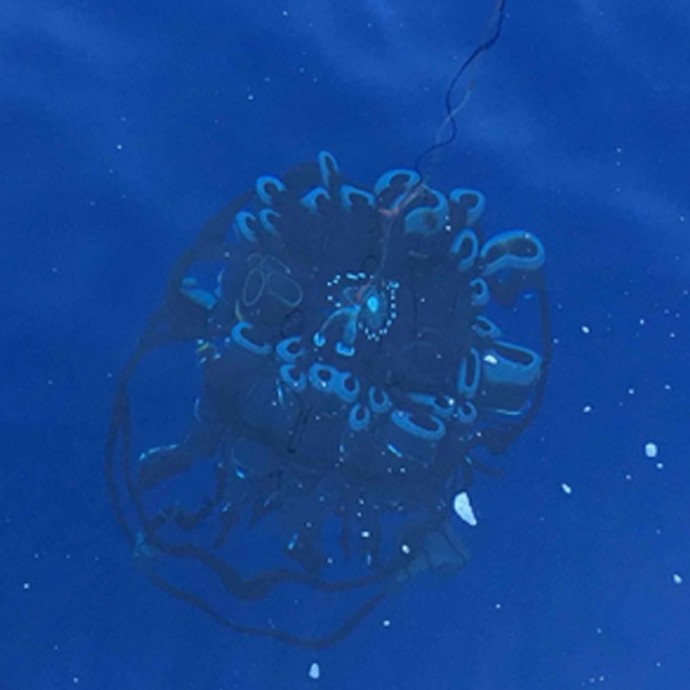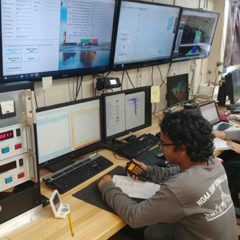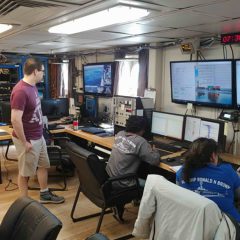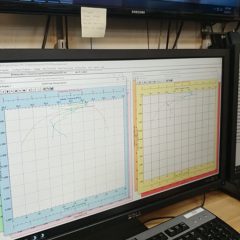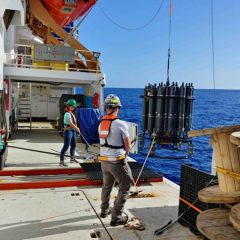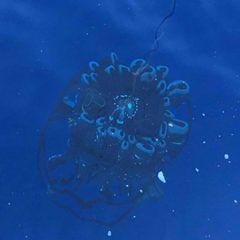Photo Gallery Story
Originally published on the I07 GOSHIP Blog. Author: Yashwant Meghare
“DON’T PANIC” are the words I have written in big letters on my notes for how to operate a CTD. My excellent teacher, Kristene McTaggart (Kristy) laughs and agrees that it is indeed a very good thing to keep in mind.
Two days later, I have a dream that I let the CTD hit the bottom while going on an unapproved bathroom break. I woke up, very disappointed with my-dream-self.
May 5th, 2018
CTD: stands for conductivity, temperature and depth, and refers to a package of electronic instruments that measure these properties. Often, CTD is attached to a rosette that holds Niskin bottles for water sampling.
Somewhere in the middle of the Indian Ocean, at the so called “Station 22” I am sitting next to the person who operates CTD when I am off my watch- which goes from midnight to noon.
– Survey. Computer. Deploy the CTD.
– Winch. Computer. Down at 30 m/min. Target depth … (well whatever the depth is at that station)
The communication is very short and limited in order to avoid miscommunication or any kind of confusion. But as the CTD goes down to the unexplored abysmal depths of the ocean, it’s not the just the CTD that’s under pressure. The operator experiences the same feeling of increasing pressure.
– Quick instrument check for any signs of technical error. All good. (Well, at least that’s what we like to see.)
As the CTD goes deeper and deeper and things start to get more consistent, the operator is relieved. (or are they?)
FAST FORWARD >> 3 hours
The process of driving a CTD down to the depth can seem very uneventful. You will have to power through with a cup of coffee or some music that will bang you awake. (Or in my case, once when Kristy hid behind the door to scare me. I didn’t need much coffee after that.)
You keep increasing the speed from 30 meters per minute to 45 and then to 60. While it does seem like an uneventful job, there are spurts of times when there’s a bunch of tasks. Keeping a log of things at the beginning is important to have the final file tell you what data is important and what can be discarded. Keeping an eye for any system errors to mark them in the log is necessary. This works much like a checkpoint system in race. Anytime there’s an issue, flag it to check it later. So, even though there’s no consistent activity, it does require your attention all the time for quality data. This includes several markers in the data file to mark the beginning of the activity, the moment when CTD is underwater, when CTD is at maximum depth, and when it is going up.
The rosette hosting the CTD is not just working to measure the salinity, temperature and depth. It is an assorted set of instruments. It has a transmissometer to measure the clarity of the water, fluorometer, LADCP, oxygen sensors, altimeter that measures the height from bottom.
The altimeter activates when the CTD is within 100 meters of the seafloor. The goal is to keep the CTD off the bottom, but just close enough that the sediments don’t get sucked up into the pump (which can cause trouble).
– All stations, CTD is at maximum depth.
FAST FORWARD >> 3 hours
The journey back up involves collecting water samples at every few hundred meters.
– Winch, standby. Winch, slowdown. Winch stop. Collect water sample.
– Winch, up.
Once the CTD is back on deck, the bottles are checked for any leaks and made sure they had been fired. The real-time data collected is copied and saved on the system. The CTD operator helps with any sampling if needed.
Once all the samples have been collected, there are other simple tasks to take care of such as setting up the CTD for the next cast. There are small details that one must pay attention to for a successful cast. Andrew Stefanick (Andy), who seems like a pro with the CTD instruments helps with and teaches me all the fine details. Uncorking the bottles and cleaning the optical sensors needs to be done in a certain manner so that the equipment is not damaged.
The wording makes it sound like the CTD is some small fragile object, but in reality, it can’t be moved without the help of electrical pulley.
The purpose of GO-SHIP cruises is to observe changes in our oceans over time and this can be done only if we have quality data. From the Niskin bottles, the water is collected to do various types of analysis. Dissolved organic radiocarbon analysis, CO2 levels, radiometric dating, nutrient concentrations, particulate organic matter, pH and alkalinity levels, dissolved oxygen concentration, CFC gas analysis, calcium analysis and density profiling are all performed on the water collected in the bottles on the CTD. So, this makes CTD a crucial part of the cruise and puts a lot of responsibility on CTD operators. With 132 CTD casts planned between Durban and Goa, this cruise will explore the Western Indian Ocean after a very long time and look for any changes that have occurred over the decades.
Image Captions
From Left:
- Scientist running the data station for CTD deployments aboard the NOAA Ship Ronald H. Brown. Photo Credit NOAA
- Scientists in the Data room aboard the NOAA Ship Ronald H. Brown., Photo Credit NOAA.
- Visualizing CTD Data, Photo Credit NOAA
- CTD device deployment, Photo Credit NOAA
- CTD Descending, Photo Credit NOAA
